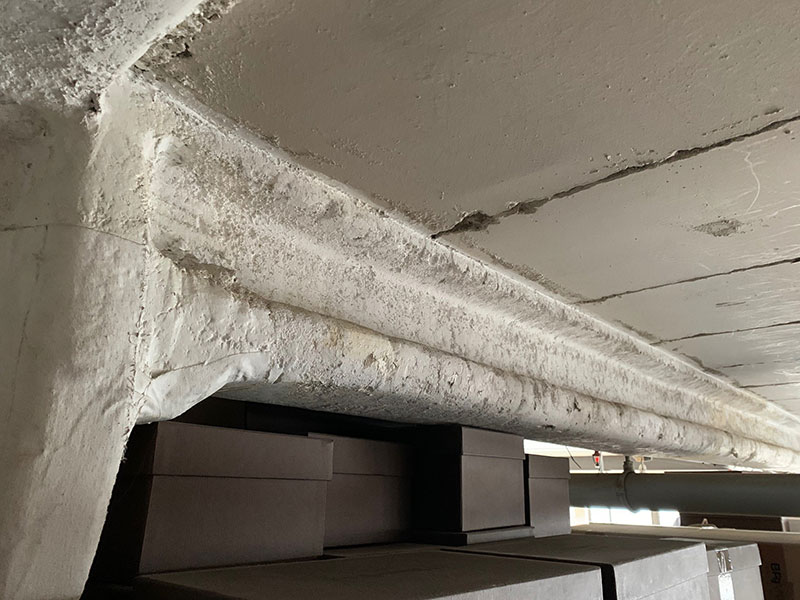What are asbestos sprayed coatings (and what were they used for?)
Asbestos sprayed coatings – also often referred to as “flock” or “limpet” – are very much what the term sounds like: literal coatings of asbestos on various surfaces. To be more specific, the surfaces were typically concrete walls, ceilings, and steelwork, and the sprayed-on mixture consisted of varying levels of asbestos with other adhesives and resins.
Especially popular from the 1950s until the 1970s – their use being gradually phased out by the end of the latter decade – asbestos sprayed coatings were commonly applied due to a wish to improve fire protection and insulation in buildings. Such structures encompassed the likes of warehouses, factories, car parks, studios, and theatres.
There is no such thing as a “safe” form of asbestos-containing material (ACM) for any given person to come into contact with, which helps to explain why all types of asbestos have been banned in the UK since 1999. However, even by those standards, asbestos sprayed coatings are particularly notorious for the dangers they can pose to human health.
This underscores the importance of building owners, managers, and other stakeholders being well-informed on what asbestos sprayed coatings are, as well as how to sensibly manage the risks they present. In this article, we will set out the essential things to know.

What are asbestos sprayed coatings?
As mentioned, asbestos sprayed coatings were created by blending asbestos fibres with adhesives and resins. The resultant mixture was then sprayed onto various construction materials for the purposes of insulation, fireproofing, and/or soundproofing.
One factor that has contributed to the dangerous reputation of asbestos sprayed coatings is their high asbestos content, which tends to be between around 55% and 85% of the overall mixture. Chrysotile (white) asbestos, amosite (brown) asbestos, and crocidolite (blue) asbestos were all historically used for asbestos sprayed coatings. The remainder of the mixture was often made up of many different non-asbestos materials.
It is also important to note the messy and haphazard way in which these coatings were normally applied – which in turn, has implications for how surviving examples can be most safely managed today. Workers used a large sprayer to apply the coatings in an imprecise manner. So, even if – for example – the sprayer was intentionally aimed at a beam, the coating would inevitably end up on nearby areas as well, such as ceilings, walls, and floors.
What do asbestos sprayed coatings look like?
As grim a health risk as asbestos sprayed coatings undoubtedly are, one of the “good” things about this potentially lethal ACM as far as safe and legally compliant management is concerned, is that it is at least relatively easy to visually identify.
A good starting point is to make sure you’re looking in areas of your building where asbestos sprayed coatings might be particularly likely to be present. Keep an eye out, for instance, for beams and ceilings in parts of your property where thermal insulation, acoustic insulation, and/or fireproofing might conceivably have been needed.
As you do so, you might notice coatings that resemble those in our online gallery of asbestos sprayed insulation. Such coatings can vary a lot in their thickness – from a few millimetres to several centimetres – and as you look closer, you might realise that you can actually see asbestos fibres. Frequently very lumpy, asbestos sprayed coatings tend to be grey-white in colour, although elements of brown and pink can also appear.
What were asbestos sprayed coatings used for?
With the naturally occurring mineral known as asbestos being noted for its fire resistance, asbestos sprayed coatings were often applied onto structural steel and concrete soffits to boost fire protection in these parts of a building. So, these coatings were an especially common sight in areas perceived to pose a high fire risk, such as underground car parks and plant rooms.
However, another common motivation for the application of asbestos sprayed coating was a wish to provide effective thermal insulation and anti-condensation material on the undersides of roofs, as well as on the sides of warehouses and industrial buildings. Furthermore, asbestos sprayed coatings were popular as acoustic insulation in theatres, halls, and cinemas.
How can you identify asbestos sprayed coatings?
Visual inspection – bearing in mind the classic signifiers we mentioned above – is certainly one way to begin identifying possible asbestos sprayed coatings. However, no one can depend on sight alone as a means of definitively confirming whether a particular material contains asbestos. So, it is likely that at some stage, you will need to have asbestos surveying and testing carried out on any given material that you suspect to be asbestos.
You might be fortunate enough to have access to an asbestos report from a previous asbestos survey carried out at your site, which could confirm whether the now-banned mineral is present. Otherwise, there might be other documentation in relation to the property – such as building records, renovation records, or inspection reports – that could provide important information and insights.
As we have written about, the fact of an asbestos survey having been conducted at your site in the past doesn’t necessarily mean it will still be accurate and valid. So, you might ultimately have a new professional asbestos survey undertaken at your building, covering all possible ACMs.
After all, in light of the 1999 ban, even the youngest asbestos sprayed coatings still in existence in the UK will be ageing, and potentially deteriorating. Such degradation could alter the nature and extent of the risk that these especially dangerous ACMs pose to building occupants and users, so you will need to be alert to this in your asbestos management.
How dangerous are asbestos sprayed coatings?
The short answer to this question is: very dangerous. Asbestos is, of course, extremely perilous to human health in any form, given that any loose asbestos fibres that are released – perhaps due to ACMs being disturbed – can be easily breathed in or ingested by someone nearby.
These asbestos fibres can then become lodged in the exposed individual’s lungs, and eventually – after many years or even decades – lead to the development of a life-threatening disease such as mesothelioma, asbestosis, or asbestos-related lung cancer. Even in the 2020s, around 5,000 deaths a year in the UK can be attributed to health conditions arising from asbestos exposure.
ACMs that are in good condition and undisturbed are believed to pose negligible risk to human health. However, asbestos sprayed coatings’ combination of high asbestos content and high friability – in other words, their tendency to easily crumble when touched – makes them a particularly serious risk. So, any improper handling of this ACM can have extremely adverse consequences.
Do you need a licence to remove asbestos sprayed coatings?
Not all work with ACMs requires the person carrying out the work to hold a licence from the UK Health and Safety Executive (HSE). However, such a licence is definitely required in the case of any work with asbestos sprayed coatings, including removal. This is in recognition of the particularly severe hazards presented by this higher-risk ACM.
It is legally mandatory for asbestos sprayed coatings to only be removed by a licensed professional. However, if it is presently too risky to arrange for removal of the sprayed asbestos coating from your site, or if the removal process cannot immediately begin, you might consider encapsulation of the material as a short-term alternative solution.
What should you do if you suspect asbestos sprayed coatings?
If you notice materials in your building that you suspect to be asbestos – whether or not they are sprayed coatings – you should cease work in the given area immediately. This will allow you to arrange for testing of the material, so that you can confirm whether it is asbestos, and take informed decisions on how to manage it.
It is vital to take steps at this stage to prevent any disturbance of the suspected ACMs. A key part of this will be ensuring no one who isn’t wearing personal protective equipment (PPE) and respiratory protective equipment (RPE) enters the area where the materials are present, for as long as investigations continue to confirm whether they are asbestos.
By contacting professional asbestos surveyors and removal experts, you can help ensure you take the necessary actions to keep users of your building safe, at the same time as achieving and maintaining compliance with the Control of Asbestos Regulations 2012 (CAR 2012).
We have previously written in detail about the appropriate actions to take whenever you find suspected ACMs at your property.
Conclusion: knowledge of asbestos sprayed coatings will help you take the right actions
As we have sought to make clear in this article, even relative to other ACMs, asbestos sprayed coatings have a reputation for being especially dangerous and easily disturbed. They are, however, at least relatively easy to visually identify, although subsequent surveying and testing will be needed to confirm whether any given identified material does, indeed, contain asbestos.
Once such confirmation has been obtained, you will then be able to proceed with the best-informed asbestos management decisions. This, in turn, will enable you to be confident of maintaining legal compliance and protecting visitors and occupants of your property.
Contact Oracle Solutions by email or phone today, and we will be pleased to provide you with a fast and free quote for any of our asbestos services.

Written by Callum McDonald
Callum McDonald is an expert in asbestos quality management, ensuring rigorous adherence to regulations and high-quality standards in removal projects. His focus on enhancing quality and client satisfaction makes him a crucial asset in safety and compliance within the field. Callum's expertise in technical support and oversight of licensed works underscores his commitment to excellence in asbestos management, providing invaluable guidance to clients in this specialised area.
